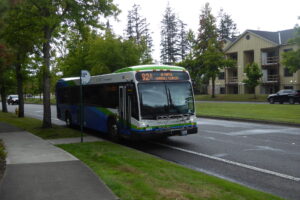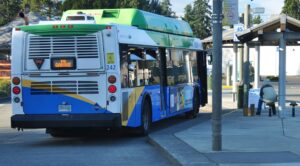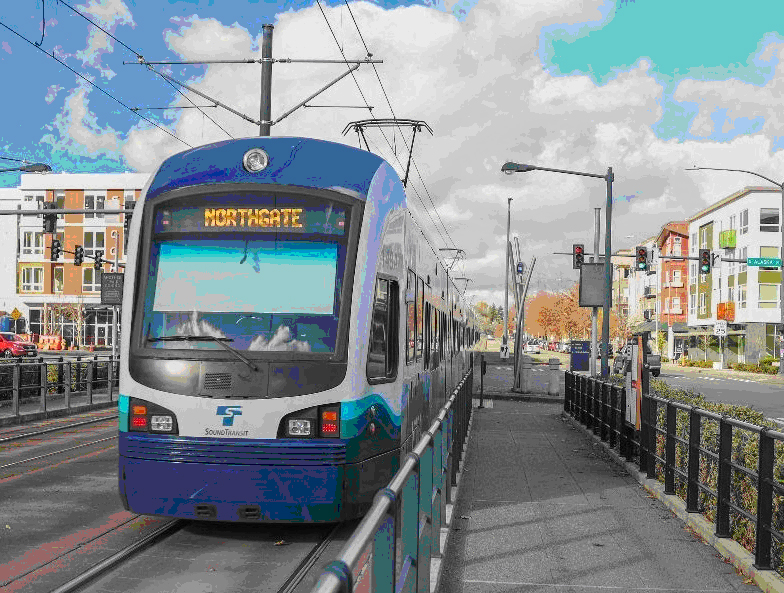Complete the Streets
By Kirk Kirkland
Streetscapes can make all the difference in a community. Just look at what University Place has done, creating a tree-lined boulevard and walkable community on Bridgeport Way.
A three year effort by Futurewise activists finally passed legislation in Olympia, implementing “Transit Oriented Developmen.” in cities and unincorporated areas. At the same time Pierce County Council and the planning department changed the zoning in Parkland and Spanaway into a classification called “Centers and Corridors.”
This specific Corridor is along Pacific Avenue between SR 512 and the Roy Y. The corridor’s new map shows multi-story apartments built in the second story above shopping, coffee shops, and restaurants. The legislation provides tax breaks for more dense development in residential and mixed use developments near bus and train stations.
Parkland already has an example of this where Garfield Street was redeveloped next to a public transit station. Sidewalks were improved and bike lanes connected the area with parks, libraries and Pacific Lutheran University.
Unfortunately Pierce County Council has changed the zoning but has not yet added “Complete the Streets” policy to county code to implement a standard of connecting isolated centers and unincorporated areas with bus stops and parks. A good examples of completed streets are in Sumner and Auburn, which are built near the Sounder Station for the commuter train to Seattle.
The City of Auburn re-vitalized their downtown by changing their streetscape: adding wide sidewalks, bike lanes and places for trees and shrubbery to create a park-like feeling walking the three blocks to the transit station. Spanaway has no train station and just one park and ride at the Roy Y. The recent addition of apartments near Roy Y failed to extend sidewalks from the new apartments to the Park and ride just 100 yards away.
Spanaway’s arterials are still created for the free movement of automobiles and not pedestrians or bicyclists. Gravel paths between schools are not safe for an increased population of school children.

Centers and Corridors zoning calls for developing pedestrian and bicycle paths throughout the corridor connecting to centers.
The focus of Transit Oriented Development includes:
- Ensuring connections from residential areas to goods and services for everyday needs.
- Seeking ways to serve the corridors with short-interval local transit for shopping and commuter trips, and express service to regional connections such as the Lakewood transit stations or the Park and Ride at SR512 which provides express bus to Seattle.
Without Complete the Streets regulations, there is no uniformity in sidewalk width or requirements to connect to adjacent centers and shopping areas. Most difficult is that local bus service does not have routes to the job destinations of over 30% of the people in these apartments, who are likely to work in King County.
To make this happen, the county could create a Local Improvement District (LID) and repave the streets with sidewalks which include a streetscape that can become a foundation that is attractive for builders and for new residents.
Using the LID concept, the cost of these improvements could be shared with builders. They would pay only for their portion of the LID. It is likely to cost less if they don’t have to add the design and construction cost to their new buildings.
In Sumner the municipal code sets these goals for new construction in Complete the Streets zone:
- The city will plan for, design, construct, an integrated transportation system that will meet the needs of motorists, pedestrians, bicyclists, and transit vehicles for residents of all ages and abilities.
- Transportation facilities, including pavement markings and signs, street and sidewalk lighting, sidewalk and pedestrian safety improvements will create streetscapes that appeal to and encourage pedestrian use.
This April the Washington State Legislature passed new legislation that would implement Transit Oriented Development (TOD) The legislation encourages more dense development in residential and mixed-use development near bus and train stations.
The state legislation includes various reductions of impact fees, tax exemptions. Grants are provided by department of Commerce to build infrastructure and assist planning departments in implementing the TOD requirements. It also provides help in creating Park and Ride facilities in these areas.
In the last two years, the Pierce County Council has passed new zoning laws that allow Spanaway to become a town with high rise apartments. These Centers and Corridors zoning changes laid the foundation for these sprawling neighborhoods to eventually become a city.
Unfortunately, Parkland-Spanaway-Midland’s “Community Plan” in the county’s Urban Growth area, lacks the taxing ability that Lakewood and University Place were given when they were incorporated in the 1990s. As unincorporated areas, they cannot elect a mayor and a city council that might change their streets to boulevards of trees growing in the center.
A public works department is needed to add bike lanes and sidewalks between schools, residential areas and the Centers and Corridors zone on Pacific Avenue. A transformation is needed as many of Parkland-Spanaway-Midland’s arterials remain two lane roads that have no shoulder or safety elements.
In Spanaway a previous attempt to incorporate the Urban Growth Area into a city did not find leadership with a shared vision. Many people feared an incorporation would increase taxes. A study of taxing capability in Spanaway also showed that a city council budget would be $1 million short and not be able to fund essential city services.
More importantly, the effort to put the choice of becoming a city on the ballot failed for lack of signatures on the petition. And many people who live in Spanaway pay lower property taxes than nearby cities. Average income for Spanaway is low, making it difficult for many residents to pay increased city taxes.
Spanaway’s lack of sufficient taxes for essential services makes the area unattractive to incorporate with the City of Lakewood or City of Tacoma. More commercial businesses are needed to contribute to city budgets. As it is now, Spanaway’s large residential area would be a drain on a nearby city’s tax base and budget.
As a Community Planning Area, Spanaway will need the county park department to keep the street trees watered and trimmed and the streets adjacent to the centers clean and trash cans emptied.

Sometimes it seems that the county’s Urban Growth Area is an orphan that is dependent on city services from Pierce County Council. Three county council members who represent Spanaway Parkland Community Plan are not a majority strong enough to direct Public Works resources to connect all the area schools with bike lanes and sidewalks into a Centers and Corridors area. They’ll need one more vote to shift county-wide funding into this community.
When the Corridors zoning was created, there was a protest from the local school district and fire district to avoid channeling the future growth of 45,000 into a large area. It would require several new schools and fire stations over time.
Now putting the anticipated growth into Spanaway will require the county government to take the next steps to make sure growth pays for itself and adequate infrastructure is built.
Passing new county code to “Complete The Streets” is a good beginning. Setting up a Local Improvement District to pave the streets of the Spanaway Corridor will also be needed. It will need to add streetlights and create a feeling of community that is attractive to new residents and to the builders who will evolve suburban sprawl into a metropolitan landscape.
Kirk Kirkland lives in Tacoma and is a member of Futurewise. He has been involved with Pierce County’s Growth Management Amendments since 1994. Previously he lived in Lakewood and University Place and watched them evolve into cities.


